Tucked away in Bolivia’s southern region is the incredible salt flat of Uyuni (Salar De Uyuni). This white desert of salt stretches as far as the eye can see, and then some more. The Uyuni Salt Flat is the largest of its kind in the world, with over 10,000 square km of impossibly flat and white collection of prehistoric minerals. For comparison, that’s the size of the Netherlands! These are without a doubt Bolivia’s most popular tourist attraction and thousands of people visit yearly to take photos of themselves as giants stepping on their tiny friends, or standing on water as it reflects the clouds in the sky (during the rainy season).
I visited as a part of my Peru and Bolivia trip and it was the ultimate highlight. The variety of landscapes during my 3 day/2 night tour was incredible and I found it to be even more impressive than Machu Picchu.
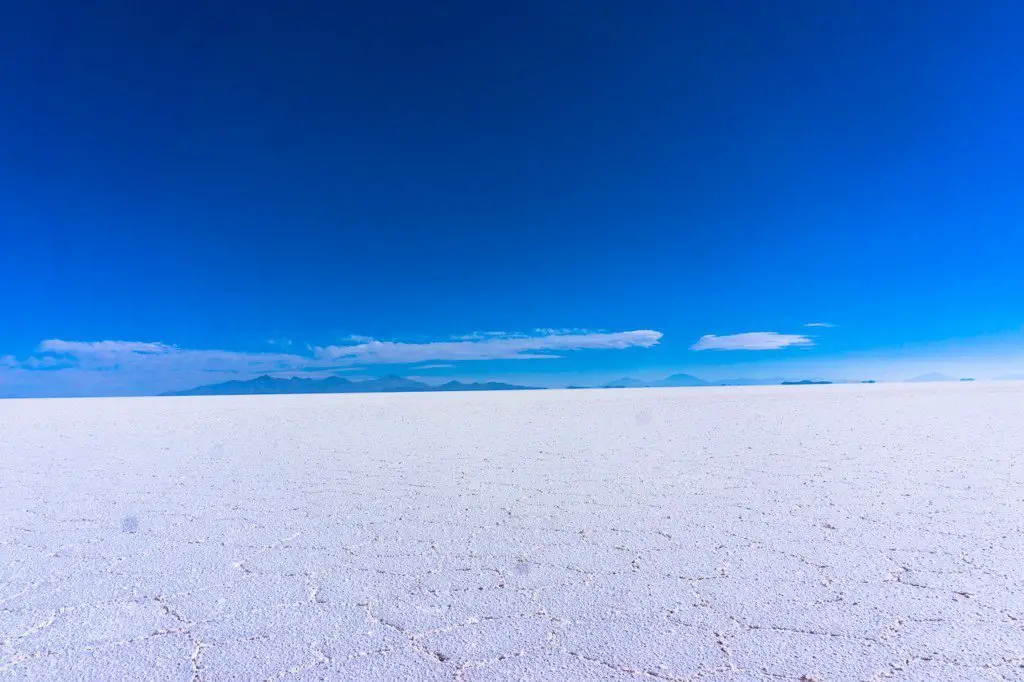
Salt Flat Tour Locations
All tours of the salt flats essentially follow the same itinerary. There are three “popular routes” depending on which city you begin the trip in. The tour covers the southwest of Bolivia and borders Chile and Argentina. The following tours are the popular options:
- Uyuni to Uyuni/San Pedro de Atacama: Duration – 3 days. Begin tour in Uyuni with the option of ending in Uyuni or ending in San Pedro de Atacama (for those traveling onwards to Chile).
- San Pedro de Atacama to Uyuni: Duration – 4 days. For travelers starting the tour in Chile
- Tupiza to Uyuni: Duration – 4 days. For travelers coming north from Argentina.

Getting to Uyuni
There are essentially two ways to get to Uyuni; flight, or bus. All options depart from the capital city of La Paz.
La Paz to Uyuni Bus:
For those that have time to spare, the 10 hour bus ride from La Paz to Uyuni is a nice option. There are a few bus companies that make this journey, with varying degrees of comfort and price. The most popular bus company is definitely Todo Tourismo, geared towards backpackers. This bus has all the amenities you could ask for on a long bus ride like big lay flat seats, movies, and even wifi! The price for the bus is 300 bolivianos ($43) one-way. Although I did not take the bus, I met loads of people that did and the ones that took it during the day all raved about the incredible scenery along the way.
La Paz to Uyuni Flight:
The flight from La Paz to Uyuni is 45 minutes. Amaszonas and BOA (Boliviana de Aviancion) are the only two airlines that fly this route. There are multiple flights per day, including an early morning flight at 7am that arrives in Uyuni by 8am. This means it’s early enough to join a salt flat tour that same day. After reading many horror stories on Amaszonas, I still ended up taking my chances and flew with them anyways as they were the cheaper option. I paid 500 Bolivianos/$75 for a one way flight.
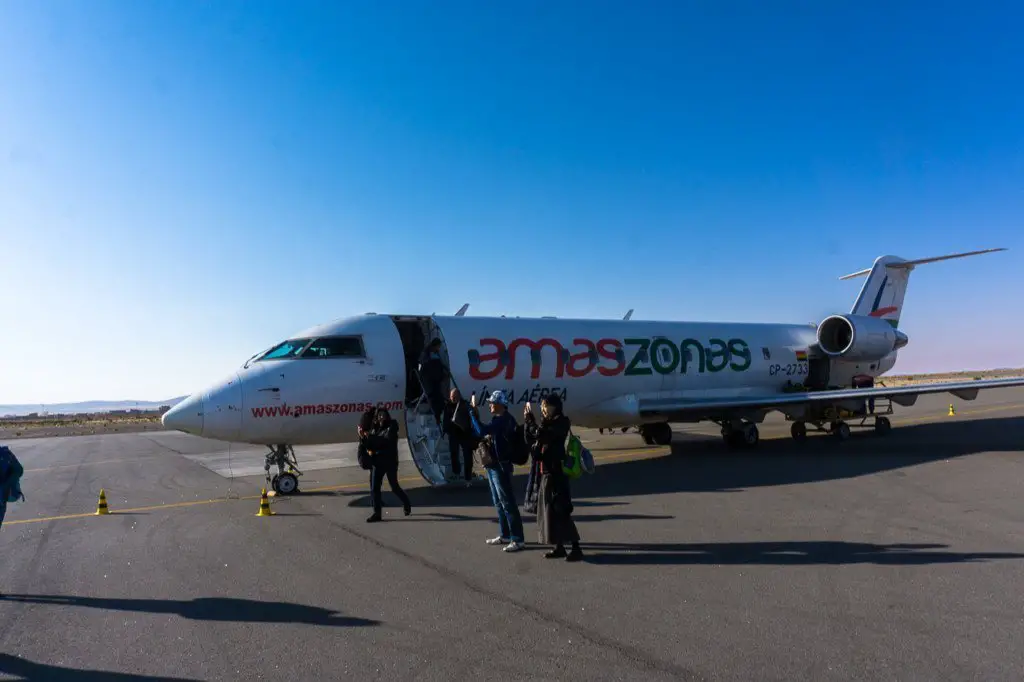
For only $30 more than the bus, I think it’s always worth it to fly! Make sure to book tickets directly on Amaszonas website for the best fares!
How many days for the Salt Flats?
Uyuni is a big tourism centered town. The main attraction is of course the amazing Salt Flats. There are a few other day excursions like visiting the mines (which I heard was actually quite cool) but largely, people come here for the Salt Flats. There are day trip options but the huge majority go for the 3day/2 night tour (there are 1 day, 2 day, and 4 day tours as well).
ALL tours follow the same itinerary, visiting the same places at the same times. There are probably a hundred different tour companies that offer the exact same tour and they will all try to sell how their tours are unique, or how they provide more. It’s mostly untrue. The tours all follow the same schedule. One reason is because if you’re in the middle of absolutely nowhere and on your own, you would be totally screwed if your car broke down.

The tours are all group tours (usually with 4-6 people per tour) including the guide and driver. Fitting 8 people in one of the 4x4s is very uncomfortable. We only had 5 guests (plus a guide and driver) and it was feasible. I’d highly recommend shopping around and seeing how many people would be on your tour beforehand.
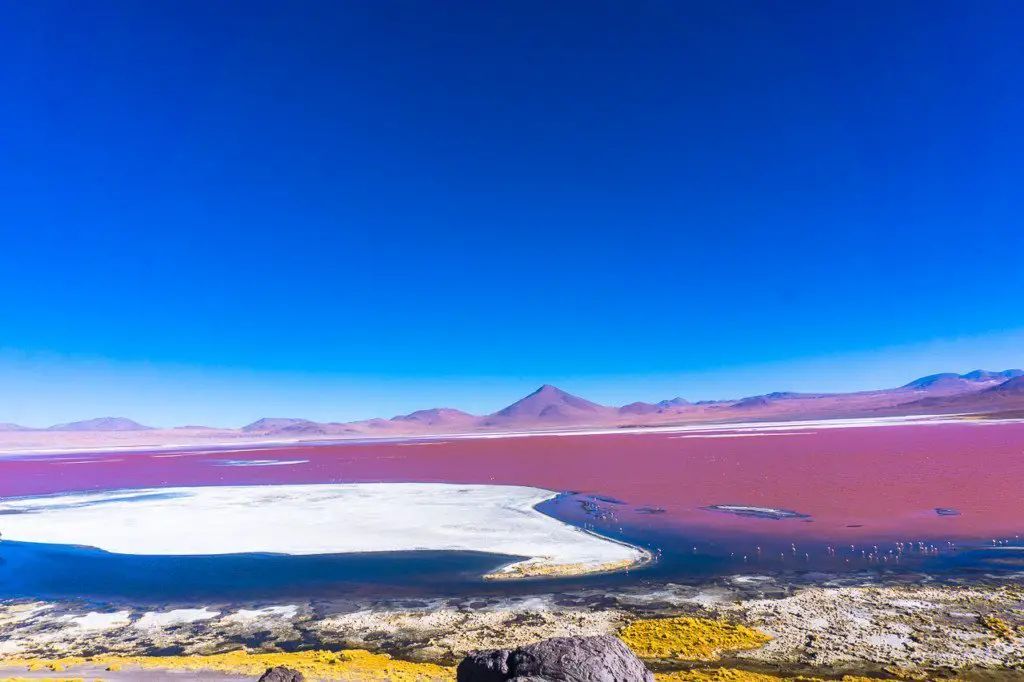
Cost of Salar de Uyuni tours
Like most popular tours in 3rd world countries, there is a huge price range of what tour operators can charge you for this tour. For the most part, a 3d/2n tour with an English speaking guide will cost between $150-200 per person. For Spanish speaking guides, the price comes down and you’re looking at between $100-150 per person. As we were time strapped, we booked our tour beforehand which turned out to be a more expensive approach. We met travelers that came to Uyuni the night before and just went door to door shopping for the best rate. The cheapest price I heard of was 600 bolivianos!
The cost of the tour includes all accommodation, all food, and all transport. There are a few park entrance fees that are not included (but not much). Even at $200, I think it’s a great deal. Bolivia is known as the least expensive country in South America after all! Most places don’t accept credit card so prepare to bring cash (either bolivianos or dollars) and there are many ATMs in Uyuni.
How to choose your Salar De Uyuni tour company
Again, the Salar De Uyuni tours are largely all standardized. Some operators will attempt to sell you on extra things like better food or bigger beds, but the tour itineraries are all the same in the end. Nevertheless, there are a few things to consider:
- How many people are there in the car? – the less, the better, of course, but it is usually 6 people + driver.
- Does the driver speak English? – We had a driver AND an English speaking guide. This means the tour costs more as we need to pay the guide as well.
- Where does the tour end? – do you want to end in Uyuni or San Pedro de Atacama? You can always decide, even at the very last minute.
- Is the entrance to the National park included? – Usually, it’s not. It’s an extra 200 bolivianos worth of national park entrance fees throughout the tour
Most tours consist of a driver and a guide. Some Spanish speaking tours will have a driver that doubles as a guide. For the most part, there is no “cooking” that is actually done on the tours. The tour operators have long negotiated with the guest houses to provide lunchtime meals for your group so all they have to do is just heat it up.
Salt flat accommodation options
The accommodation options are basic dorm-style guesthouses. They call them “salt hotels”, as parts of the building are indeed made of salt, but it’s really just someone’s house that has been turned into dorm style accommodations. There is no heating, wifi, and only some places have hot showers. Most places have a place to charge your phones and cameras.
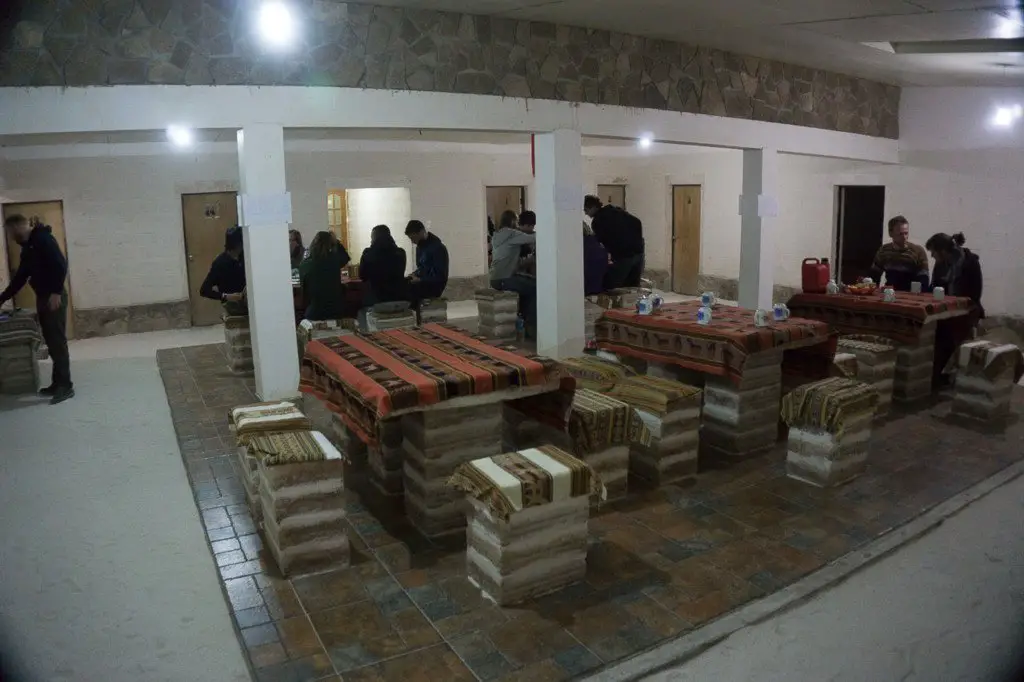
It can and will get cold at night as there is no heating, but they provide ample blankets. The tour operators will also offer you sleeping bags for rent, and this came in really handy on the second night of the tour as it was freezing.
What to pack for the Salt Flats
For the 3 day Uyuni tour, you’ll be taken through a huge array of different landscapes and temperatures. As the salt flats are high in altutide (3500m – 4500m) and extremely dry, the days are comfortable as the sun keeps temperatures reasonable but the nights are absolutely FREEZING. Winter is the dry season and temperatures can get to 20c during the day but can plummet to -30c at night! During the summer months, the days can reach 35c but the nights are still cold at below freezing temps.
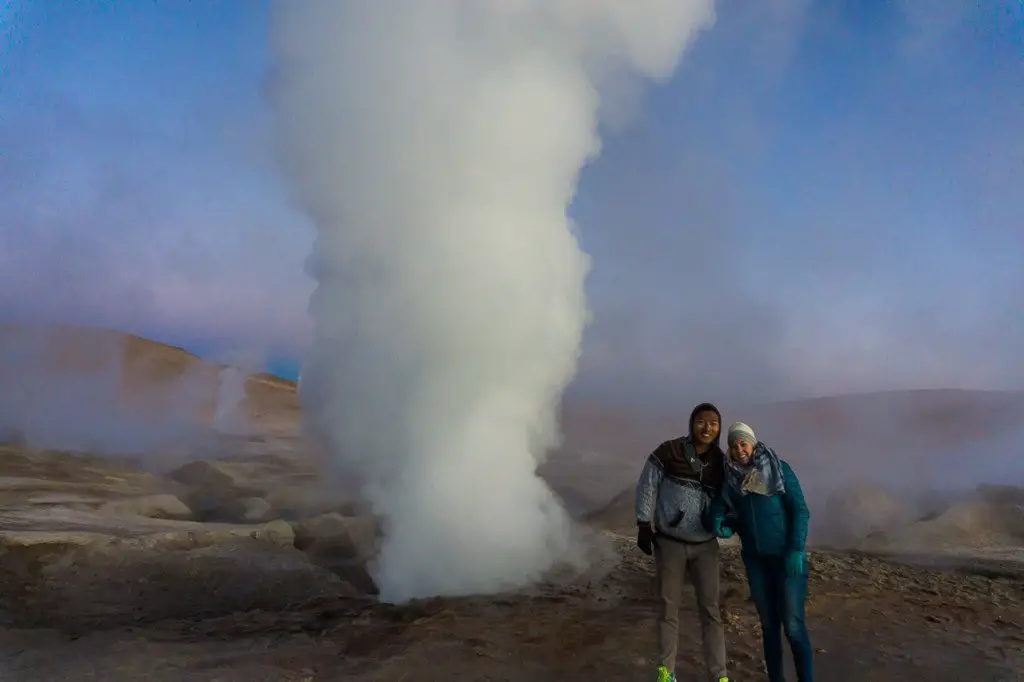
Essential packing list
- Good sunglasses – This is KEY for the salt flats. The white salt reflects the sun like crazy and it was hard to open my eyes without sunglasses
- Sunscreen
- Gloves
- Towels
- Camera, charger, and extra batteries
- Water (4L per person)
- Cash for the entrance fees and alcohol
- Toilet Paper
- Warm socks
- Sleeping Bag (Can rent from tour operator at the beginning of the tour)
The town of Uyuni
Everything I read about Uyuni was that it was a town with nothing to see and strictly a place to get in and get out after seeing the salt flats. I pictured it to be some sort of ghost town in the middle of a desert. I was pleasantly surprised. There are multiple markets and loads of decent local style food in Uyuni (of course, there are also overpriced tourist places selling pizzas and burgers). While I didn’t spend any extra time in Uyuni, I don’t think it would have been the end of the world if I did.
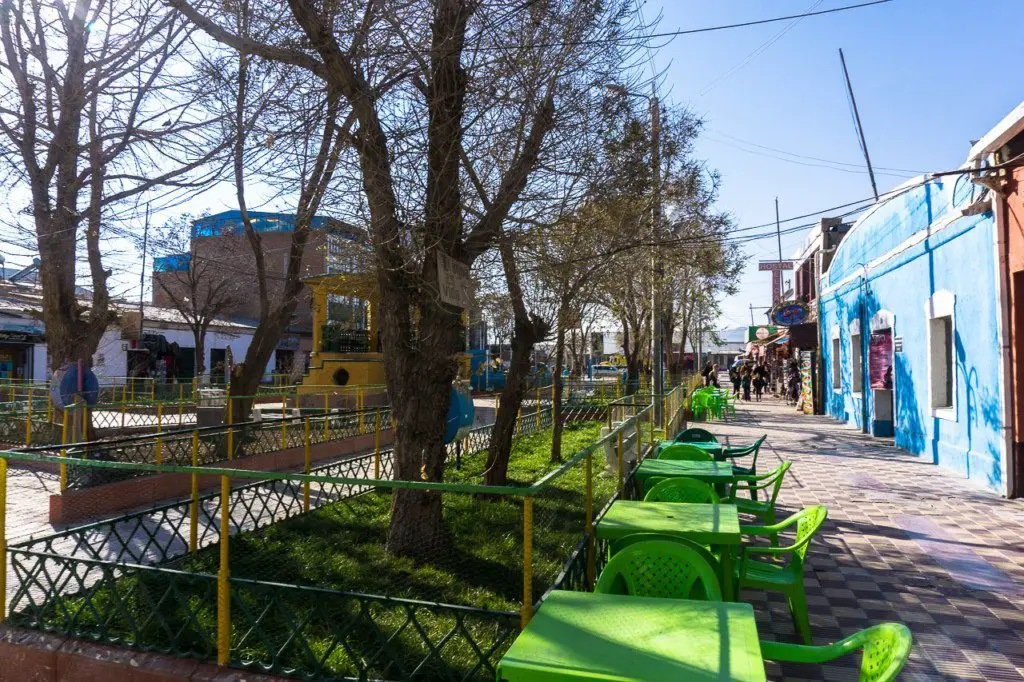
For those that want nothing to do with Uyuni, it’s possible to fly from La Paz to Uyuni the day of the tour, and join a tour departing the same day. The tour finishes around 5pm on the 3rd day, and you can fly out that same night so to never spend a night in Uyuni. The airlines specifically designed the flights for this purpose. This is what we did, and we still had a few hours the morning of, and the night after the tour ended to explore a bit of the town.

Salt Flats Tour – Day One
We left our hotel in La Paz around 5:30am for our 7am flight to Uyuni. Amaszonas was on time, with comfortable and new jets. The flight was less than an hour, on time, and had beautiful views.
From the airport, our tour operator was already waiting for us. The drive into town is only 5 minutes and we were dropped off at the tour office. After making our payment, meeting our guide, and getting all the formalities sorted, we had a few hours to kill before the tour started at 10:30am. We took this time to stock up on water, ending up with 10L for two people. I also took this time to buy socks just in case I might freeze to death on the second night.
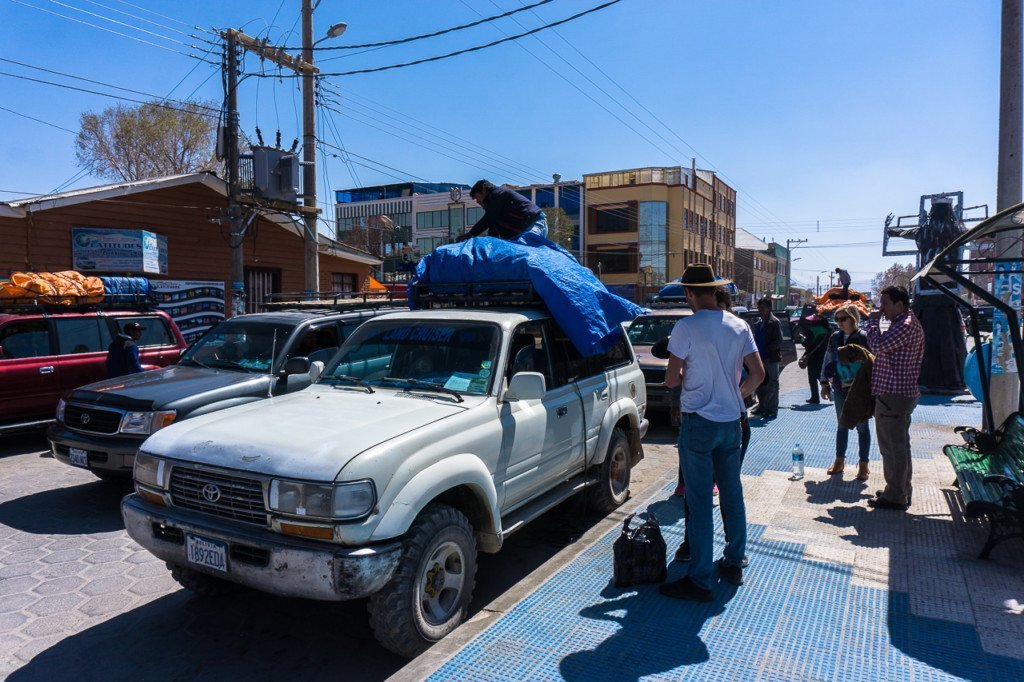
As we had just arrived in Bolivia the night before, I needed to try the famous Bolivian saltenas, a soft oven-baked empanada with meat and juices inside. We found loads of people selling them in carts and they were indeed delicious. Highly recommended.
Cementerio de Trenes
First stop on the trip is the old Train Cemetery right outside of Uyuni. A ghost town of sorts, this place is a large collection of 19th century locomotives dating back to the days when train transport was king in Bolivia. Over time, train travel was abandoned and somehow this area turned into a graveyard of sorts for obsolete technology.
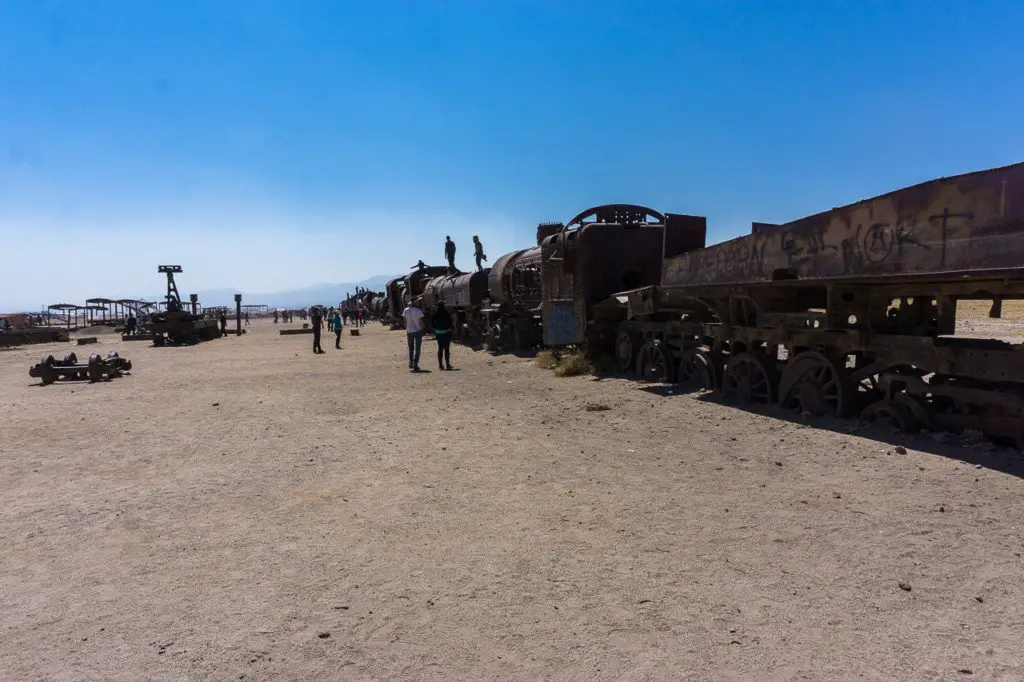
Nowadays, it’s a playground for tourists with all train equipment in tact including swings and see-saws. Oh, and it’s also an amazing spot for a photo!
Uyuni Salt Flats – Salar De Uyuni
From the train cemetery, it was time to go to the ever so famous Uyuni Salt Flats. It is not far from the town of Uyuni, and can be easily done as a day trip as well. These are the largest salt flats in the world by far, at the size of the Netherlands.

We stopped for lunch at a hotel completely made from salt. Lunch was alpaca steaks and quinoa. As far as tour food goes, this actually wasn’t that bad. The steak was totally overcooked but it was still doable.

After lunch, we made our way deeper into the salt flats to take those iconic depth and perception photos that have made the salt flats world famous. The Uyuni salt flats are incredible. Honeycomb shaped salt as far as the eyes can see, so white and so bright that your eyes are forced to squint. The salt crystals are extra salty too so just in case you forgot to bring salt with you on the trip!
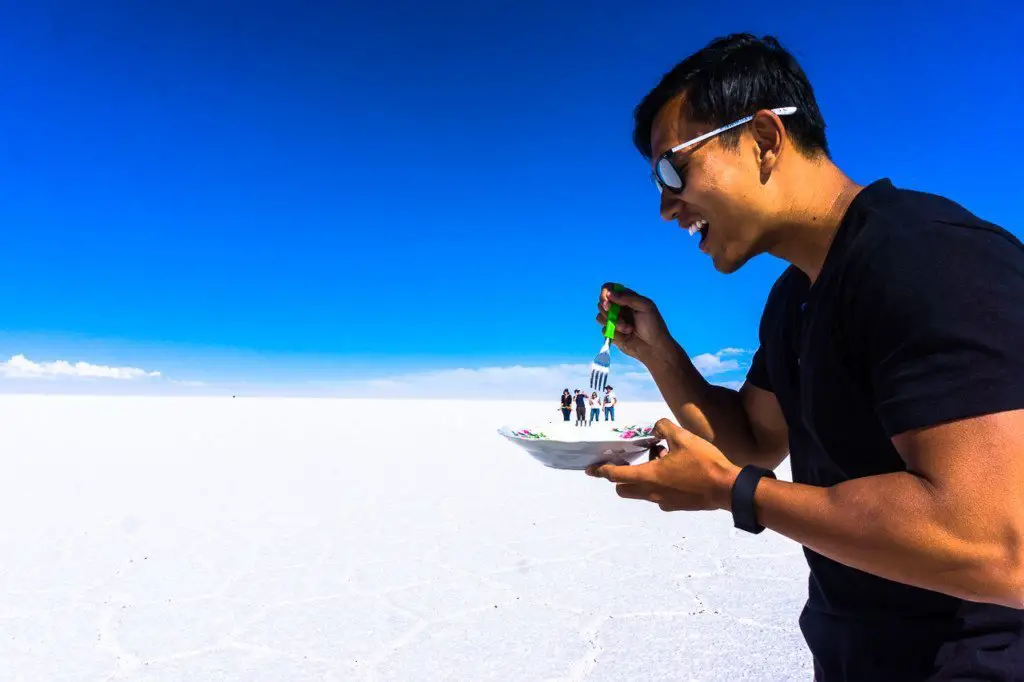
We stopped for at least 40 minutes to take our photos. We had a lot of fun getting our optical illusion shots. To take the best photos, it all depends on the pedigree of the person taking photos. Thankfully, your driver/guide will have done this hundreds of times and know how to get the best pictures.

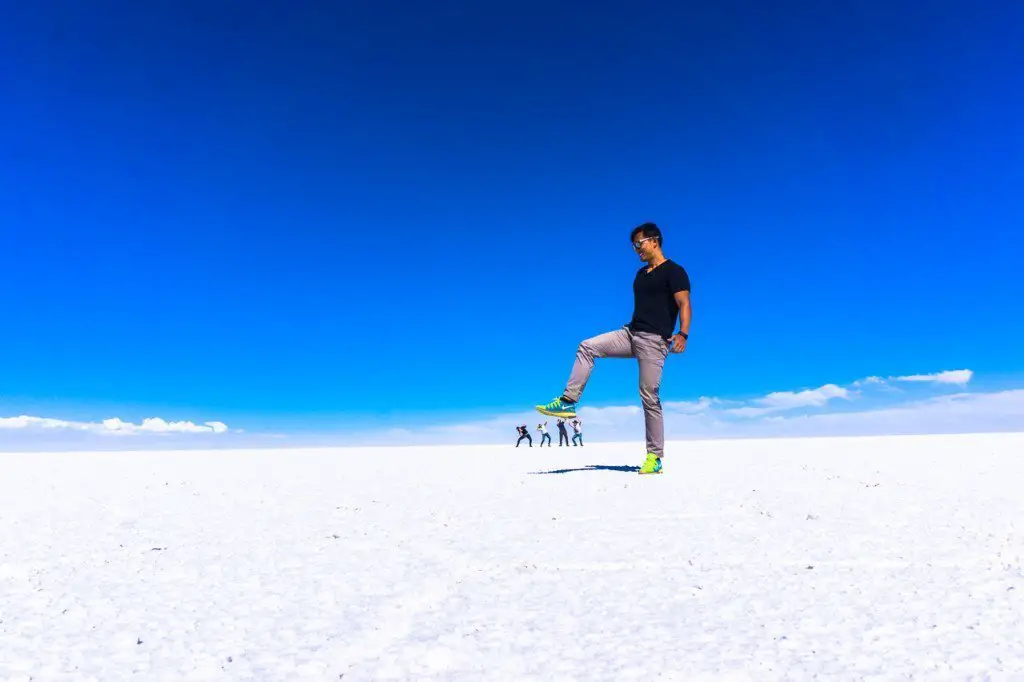
I could have stayed here for another hour but we had an itinerary to follow and the next spot was even more amazing.
Reflective Salt Flats (Rainy season only, Jan-Apr)
In addition to the iconic all white photos of the Salt Flats, the other equally as famous photos are the impossibly reflective ground where a person looks like they are walking on water as the clouds are reflected below them. These photos are only possible during the rainy season (Dec-Apr) where the salt flats are actually flooded and a light layer of water covers the salt. It’s worth a visit back to the salt flats just for this reason alone!

Isla Incahusi
This was one of my favorite spots on the trip. Located deep into the expansive salt flats is an “island” with thousands of giant cacti. It’s absolutely strange to see a rock island in the middle of the salt flats. There’s an entrance fee to be paid here but it’s 110% worth it. It’s an easy hike to the top of this rock island but the views are out of this world. Surrounded by giant cacti, looking out to the never ending white salt ocean is something I won’t soon forget.

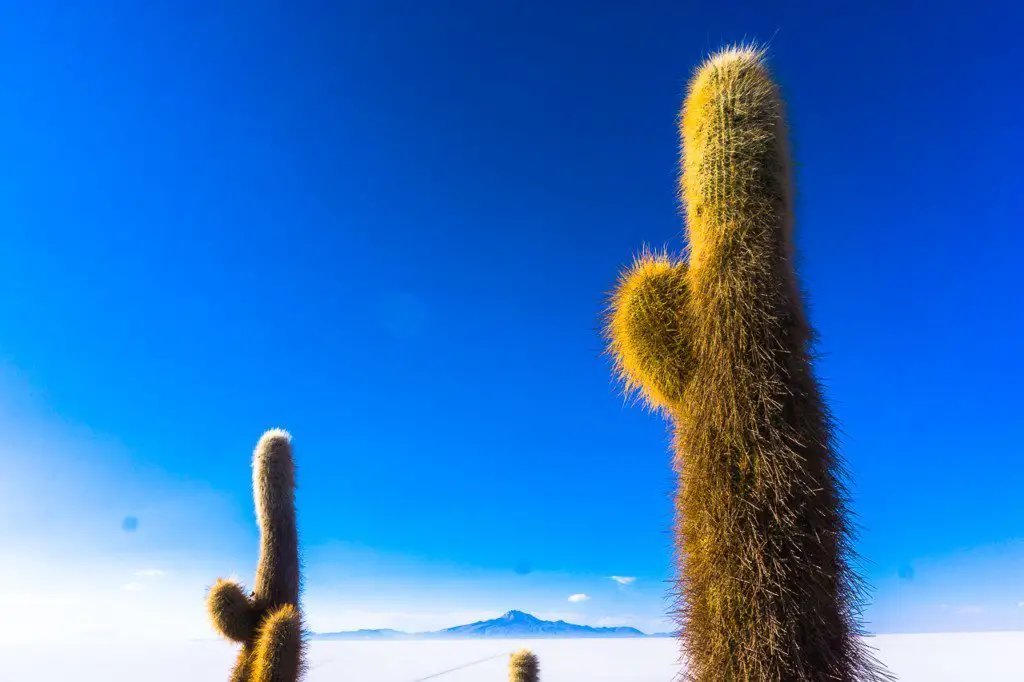
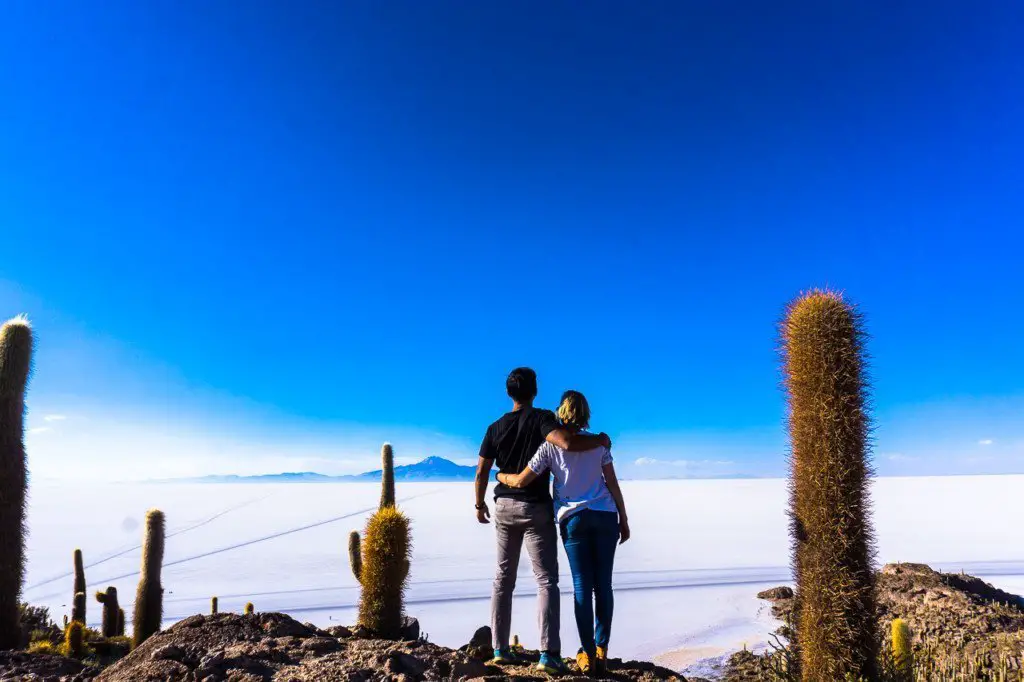
Sunset in the Salt Flats
Shortly after Isla Incahuasi, our driver took us away from the crowds so we could enjoy the sunset over the salt flats.

After spending some time here, our driver drove us to a secluded spot in the salt flats to enjoy the sunset over a mountain. We saw a small town at the base of the mountain and it turns out some local people actually live in the salt flats. That’s a tough life no doubt. It’s freezing at night, NOTHING grows in a ground made of salt, and they’re close to nothing. The one upside is they will never have a shortage of salt.

Night 1 – Salt Hotel around Uyuni
We got to our accommodations shortly after sunset. When I first read “salt hotel” in the itinerary, I wasn’t getting my hopes up but I had in mind something just a tiny bit more extravagant. I would hardly call the place we stayed a “hotel”. Basic dorm would be a better word! There were a dozen rooms in this house/dorm, with the common area as our dining area for dinner. Three other salt flat tours stayed at the same hotel and we all ate dinner together.

It was crafted with salt, and the ground was sand, giving it somewhat of a rustic vibe. There is no wifi here, or anywhere on the tour for that matter, but there are charging ports for the cameras, and a shower (with hot water option for a fee).
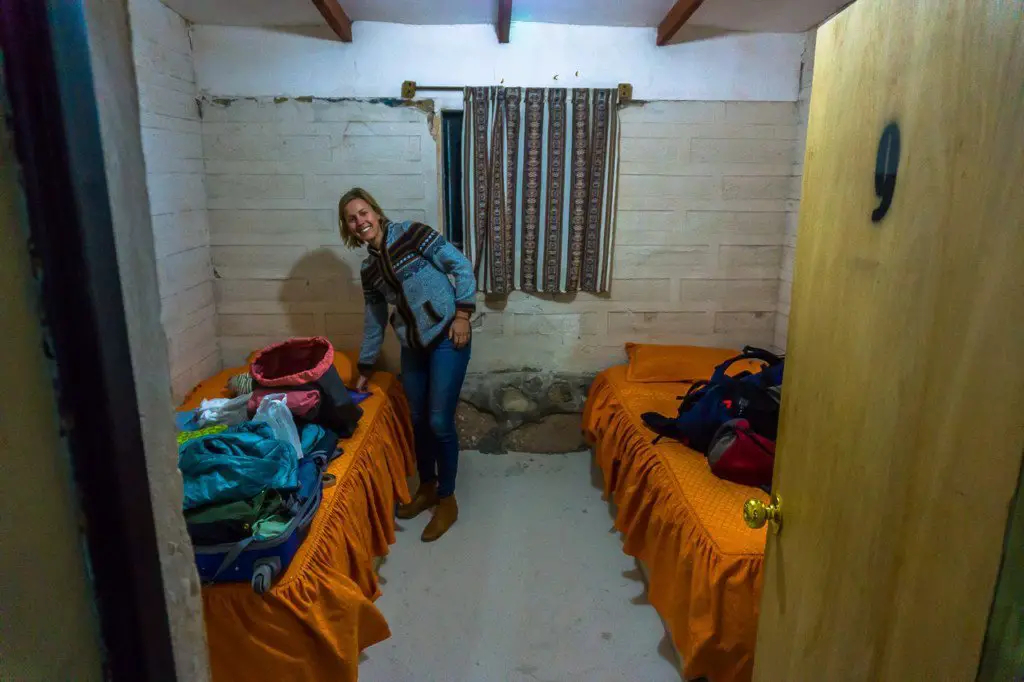
Our dinner was pretty good for being out in the middle of nowhere. Chicken, quinoa, soup, and vegetables were on the menu. After dinner, there wasn’t much to do besides sleep or drink. So we chose the latter. We sampled all the Bolivian beers: Pacena, Potosi, and Huari, along with some wines. Some of the beers were surprisingly good, especially the Huari. Wine is grown locally as well in the mountain regions bordering Argentina.
We finished the night, or should I say, the night was finished because of a bottle of Singani we drank between us. Singani is the national drink, akin to Peruvian Pisco.
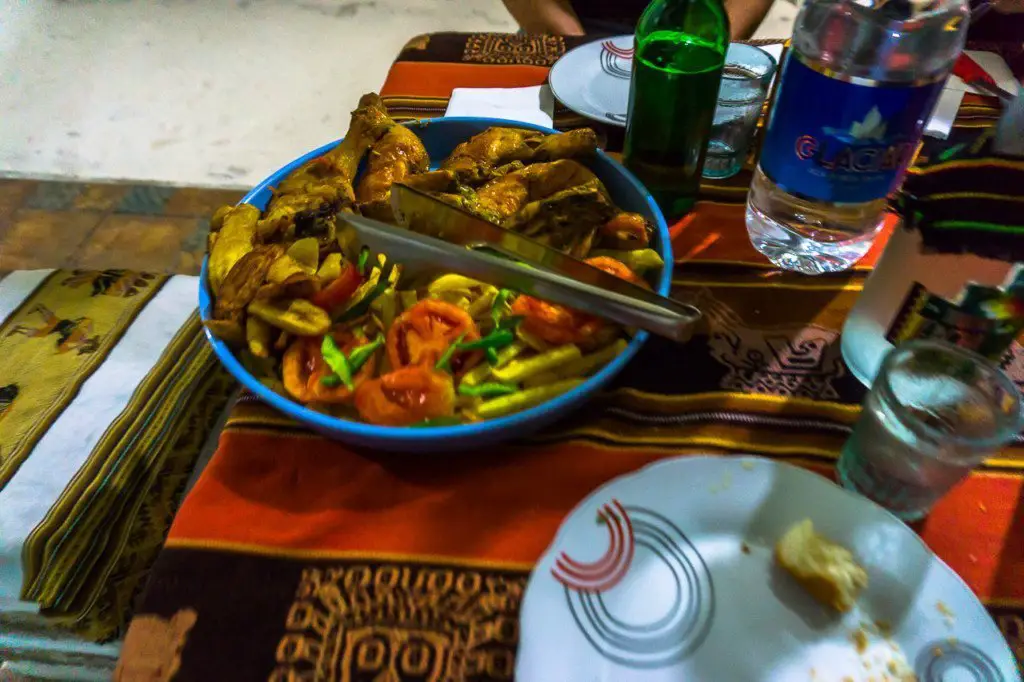
The first night was not that cold. They hotel provided us ample amounts of thick wool blankets where I could sleep without worrying about being cold! No sleeping bag was needed.
Salt Flats Tour – Day Two
The second day started early around 7:30am. We had a full day of sight seeing ahead of us as we would visit numerous lagoons, parks, deserts, mountains. It really was sensory overload. We drove through one amazing landscape after another. Salt Flats would turn to mountains, mountains would turn to desert, desert would turn to marshland, marshland would turn back into mountains.
Old Train Tracks
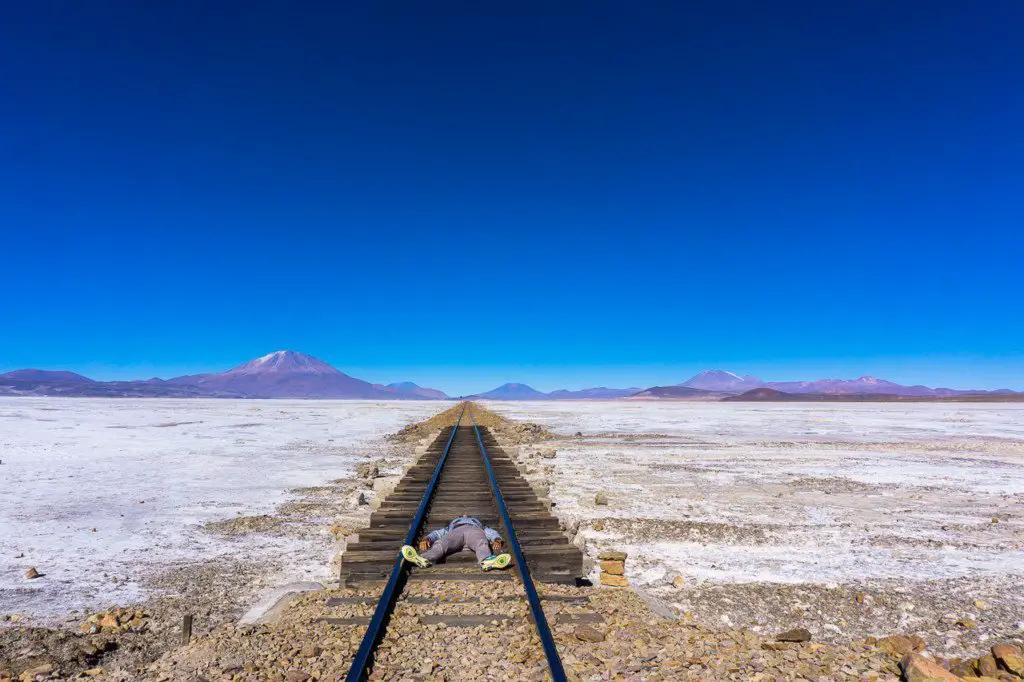
This is seriously some of the most beautiful landscapes on Earth. We cruised through the martian lconandscapes with our drivers obsessive 80s playlist blasting on repeat. I swear, something about Bolivian drivers and 80s music, but whatever gets them going. The tour starts from Uyuni and heads south towards the border of Bolivia and Chile.
We started the day with a visit to old train tracks. Paired with the depth illusion of the salt flats and mountains, this made for cool photos.
Chiguana Desert
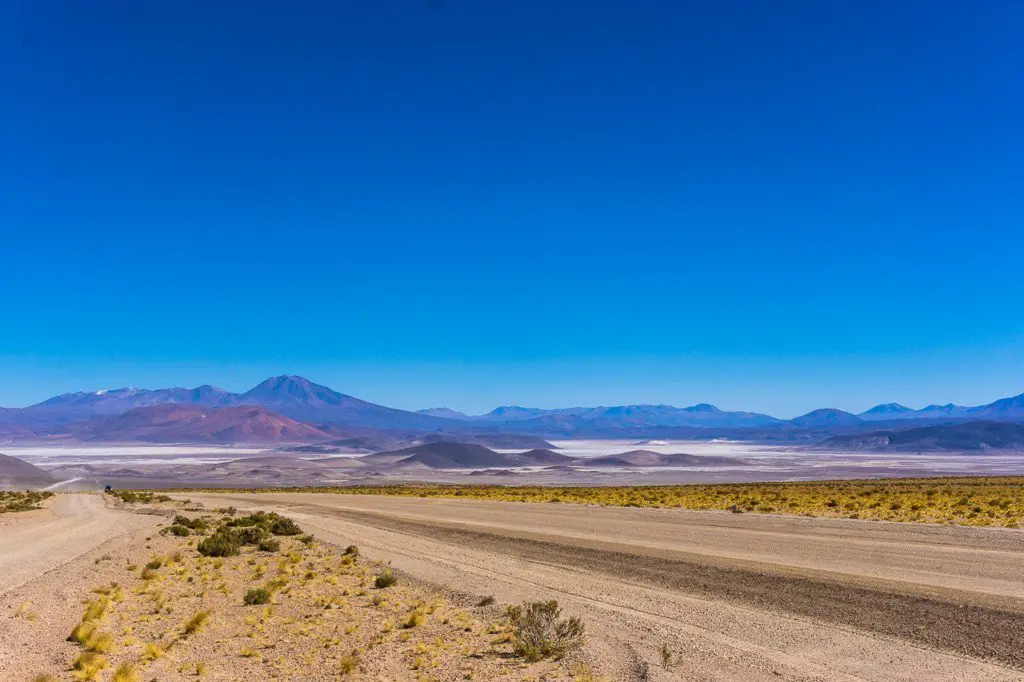
We then started our long drive south until we arrived in the Chiguana Desert. From here, we had great views of the Tunupa volcano, one of the largest volcanoes in South America. The landscapes by this point had completely changed, which I suppose is only natural as there’s few places like the Uyuni salt flats in the world! Instead, the roads were hilly, shrubs of deciduous plant life dotted the horizon, and giant mountains surrounded us. It was also colder at this point as we were also climbing in elevation (the tour starts at 3700m, and ends near 4500m).
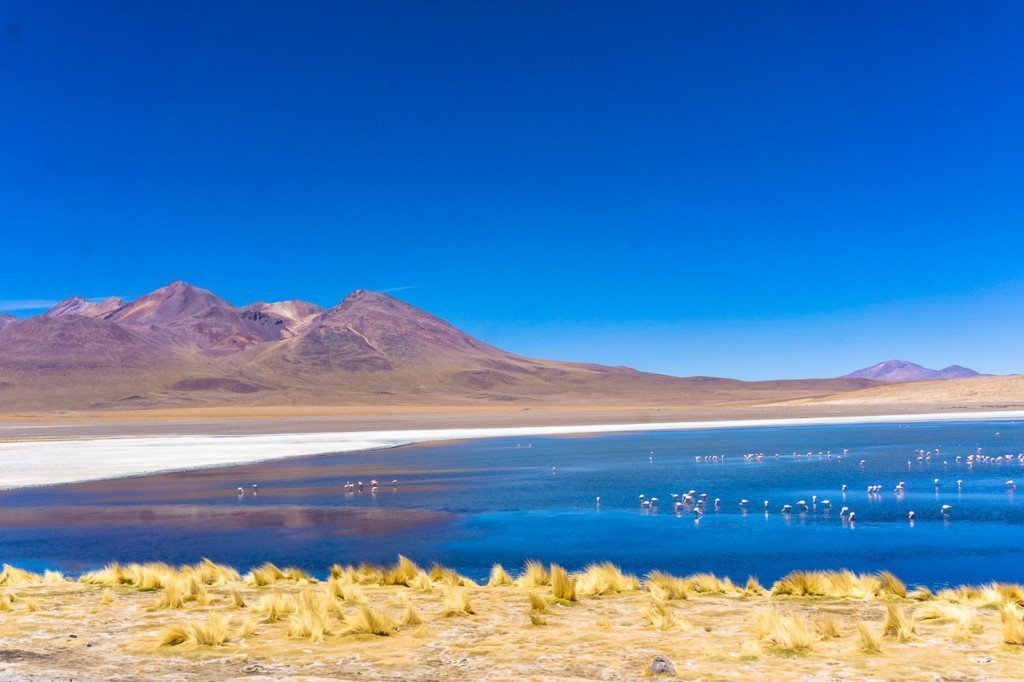
Next on the list were stops to various lagoons. Crazy to imagine such large bodies of water at 4000m! They were all filled with flamingos as the water is teeming with algae.
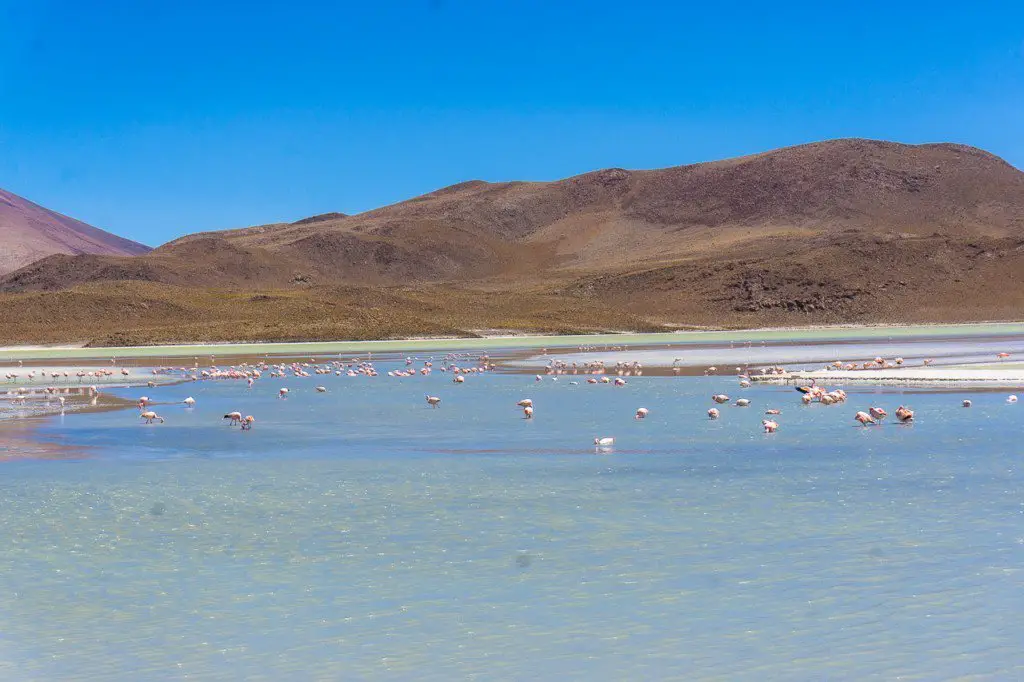
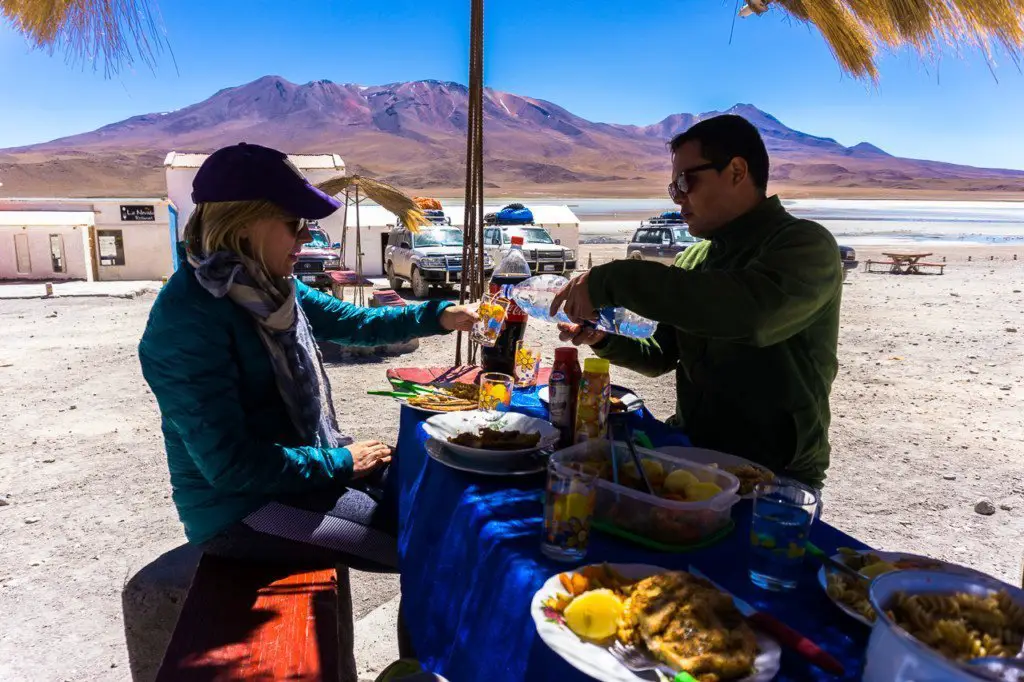
Desert of Siloli
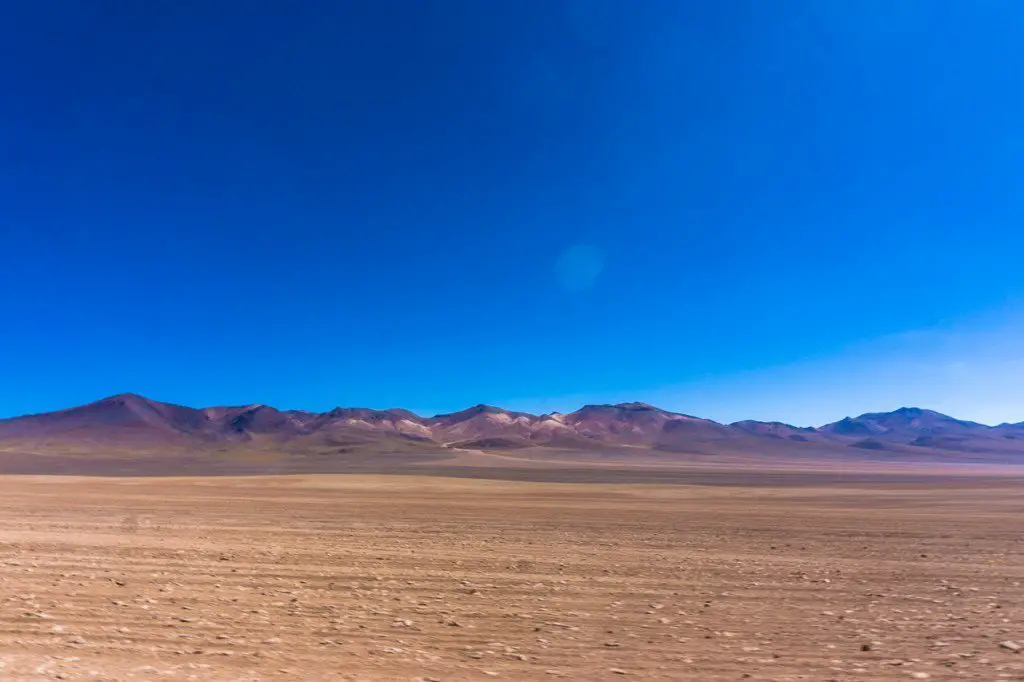
After lunch, we proceeded further south to the big desert of Siloli. The landscape was changing still to a more barren, sandy, desert-like wasteland. In this desert is the famous Arbol de Piedra, essentially a large rock formation that resembles a tree. It’s surrounded by other rock formations that form all shapes and sizes. I’ve seen similar things in the Sahara, but this place paired with the amazing landscape is something not to be missed.

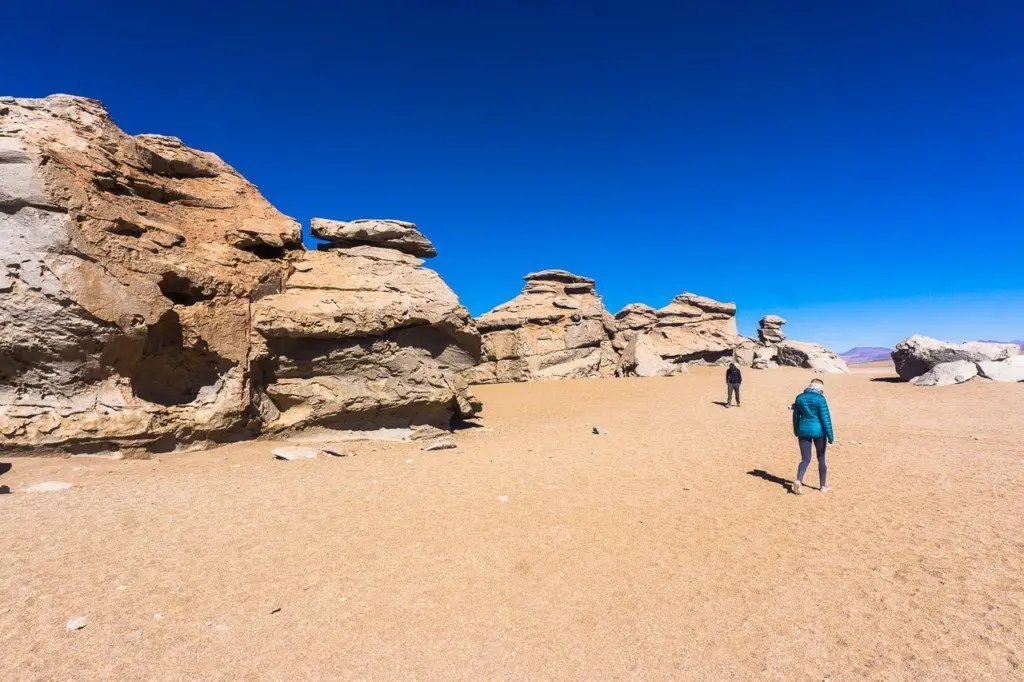
Red Lagoon – Eduardo Avaroa Reserve
At this point, it was already getting late in the afternoon and I was already getting overwhelmed by amazing. I had seen so many things already and my camera was about to die. Thinking the day was almost over, we had one final stop as we entered the Eduardo Avaroa National Reserve, the Red Lagoon.

I thought I had seen some amazing things already but this place blew everything else away. This Red Lagoon, or known as Laguna Colorada, was by far the largest lagoon we saw. The water is blanketed by red algae giving it a red-maroonish tint, which paired with the stunning mountain backdrop, salt platform, flamingos, and cacti, made this place absolutely picture perfect. The contrast was just so incredible. I wish I could have stayed near this place as I could have spent an entire day just looking at it.
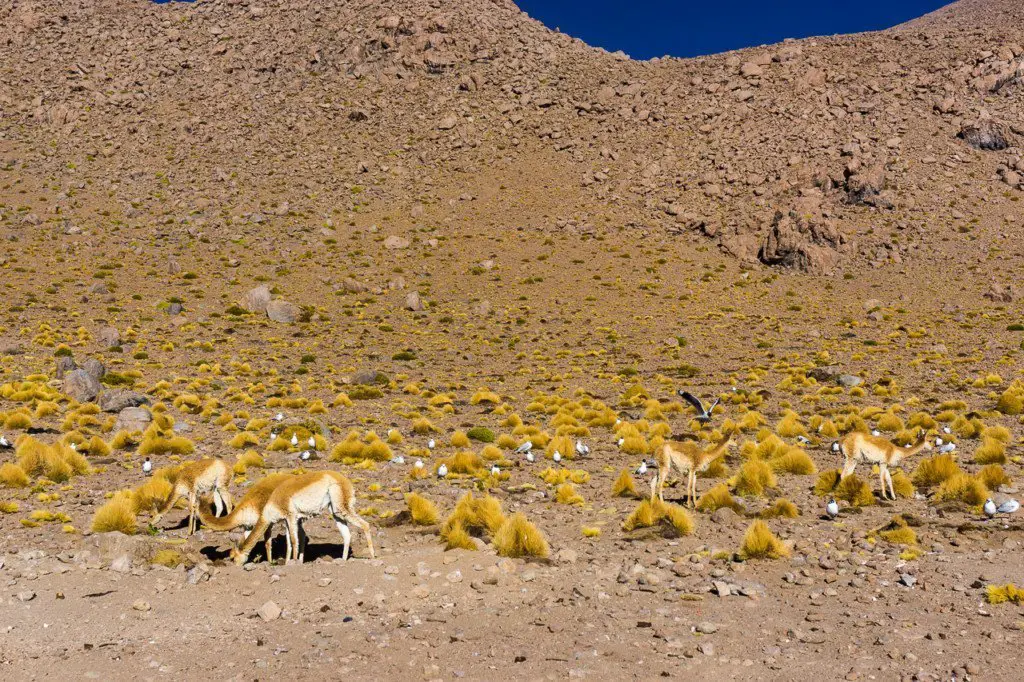
Night 2 – Freezing in my sleep
Our accommodation the second night was of similar fashion to the first night; basic dorm style houses where I think the locals actually live full time? Frankly, I have no idea how anyone survives out here. It is TOUGH living. There’s literally nothing here, you’re at 4000m+, and it’s freezing. The second night was far colder than the first. As soon as the sun went down, temperatures were near freezing.
By 10pm, it was well below freezing (in July-Aug, it can reach -30). There’s no heating and no hot showers here. I actually slept in my pants here as it was bone chilling cold. The sleeping bag I rented came in handy for night two.
Salt Flats Tour – Day Three
After a long and cold night, we woke up at 5am so we could catch the sunrise over the geysers. It was tough getting up. My body had already warmed up to the four layers of blankets covering me making it that much more difficult to embrace the still sub-zero temperatures of the house. However, the plan for the third day was to visit the “Sol Manana” Geysers and have an early morning dip in the hot springs.

Sol Manana Geysers
I’d highly recommend skipping breakfast. We voted as a group to have breakfast after the geysers and hotsprings which turned out to be the best of decisions. We got to the geysers right as the sun was rising and were the only people there. I’ve seen geysers before, and much larger ones at that in Yellowstone National park but it’s the landscape of Bolivia that makes the experience here. It felt like we were on a different planet as we walked around the geysers blowing up one after another.

Hot Springs

As soon as the first cars started arriving, we made a break for the hotsprings. What a great choice. We were the first people here! After freezing all night and all morning, words can’t begin to describe how amazing it felt to jump into this natural hotspring. We even bought a bottle of wine for the occasion to celebrate an amazing 3 days. Red wine for breakfast? Why not?

After almost an hour spent in the hotsprings, other tour-goers started to flood in and it was our queue to leave. We had our breakfast shortly and left. The effects of the hotspring left me feeling warm for the rest of the day despite the still near freezing temperatures.
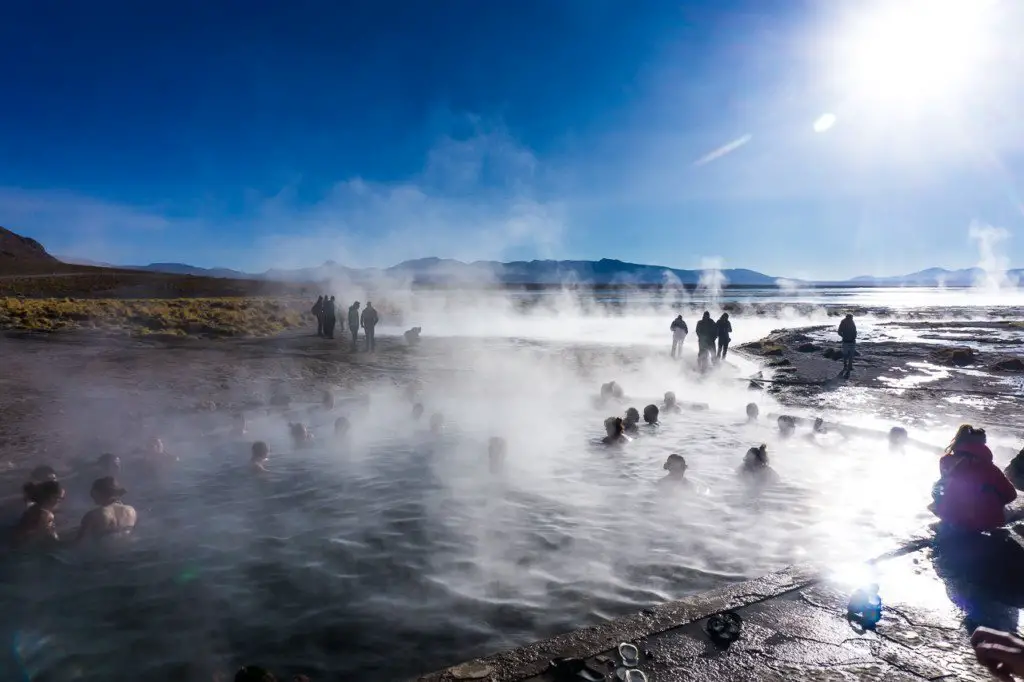
Laguna Verde – Green lagoon
Last stop on the trip was the Green lagoon! This place, like the Red Lagoon, is famous for its water that is tinted a shade of green from arsenic and other minerals.
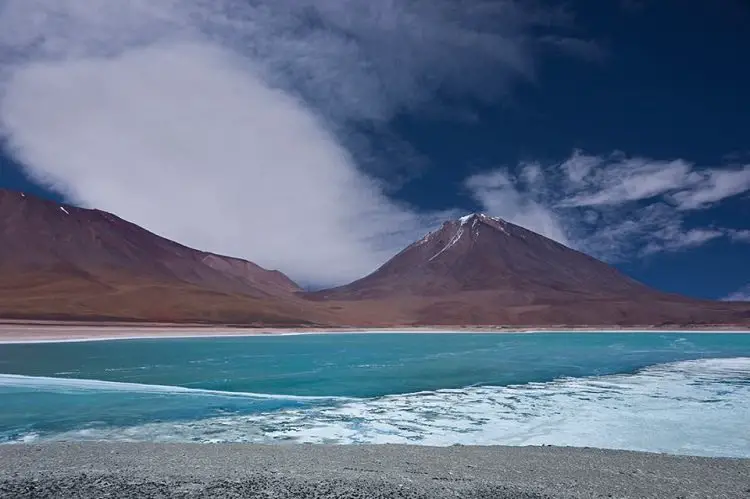
At this point, we drove to the Bolivia-Chilean border. It’s here that we dropped off two of my fellow tour goers as they continued their tour into Chile and to San Pedro de Atecama.
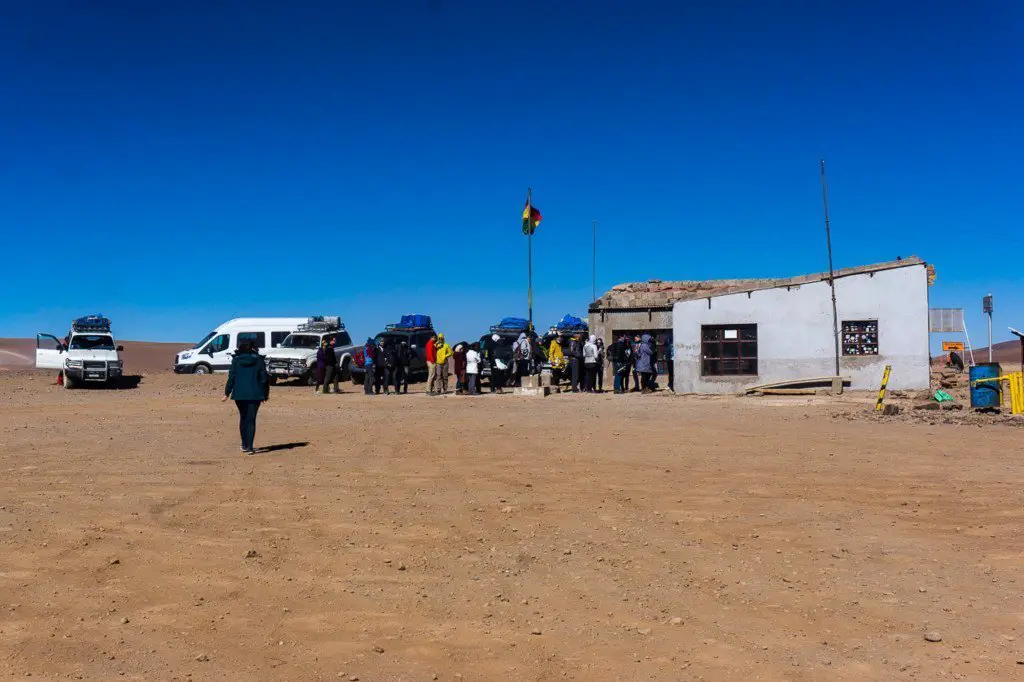
From the border, we drove straight back to Uyuni, making a few rest stops along the way, arriving in town by 5pm. We had plenty of time before our evening flight on Amaszonas back to La Paz.

All in all, this three day tour around southern Bolivia was one of the best tours I’ve ever done. I actually felt Bolivia was more spectacular than Peru after this trip and I will definitely come back to the salt flats during the rainy season!



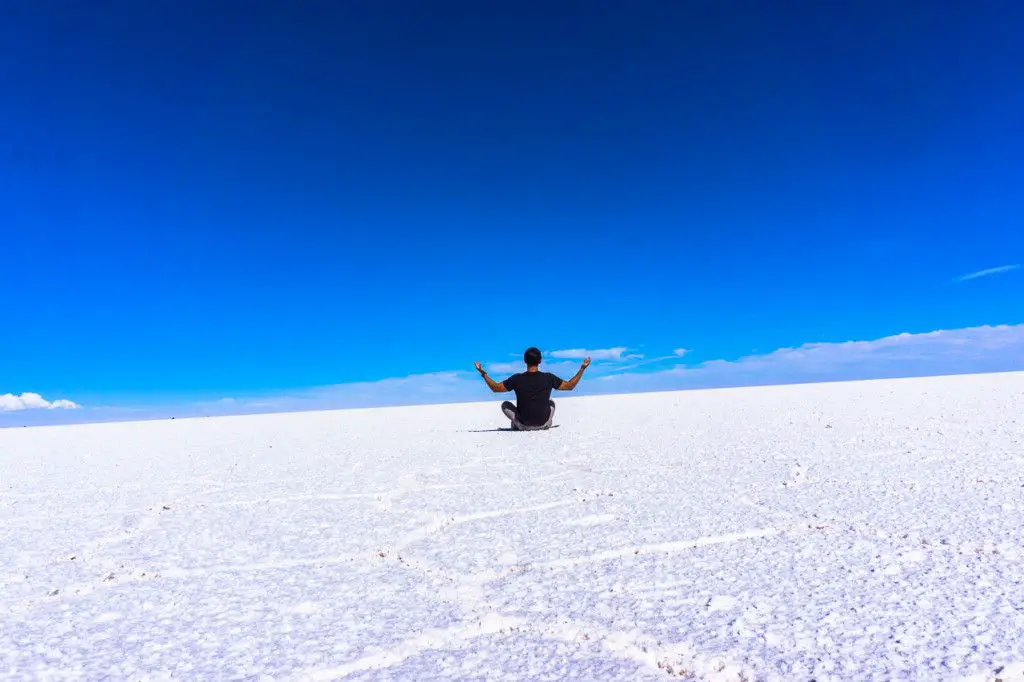
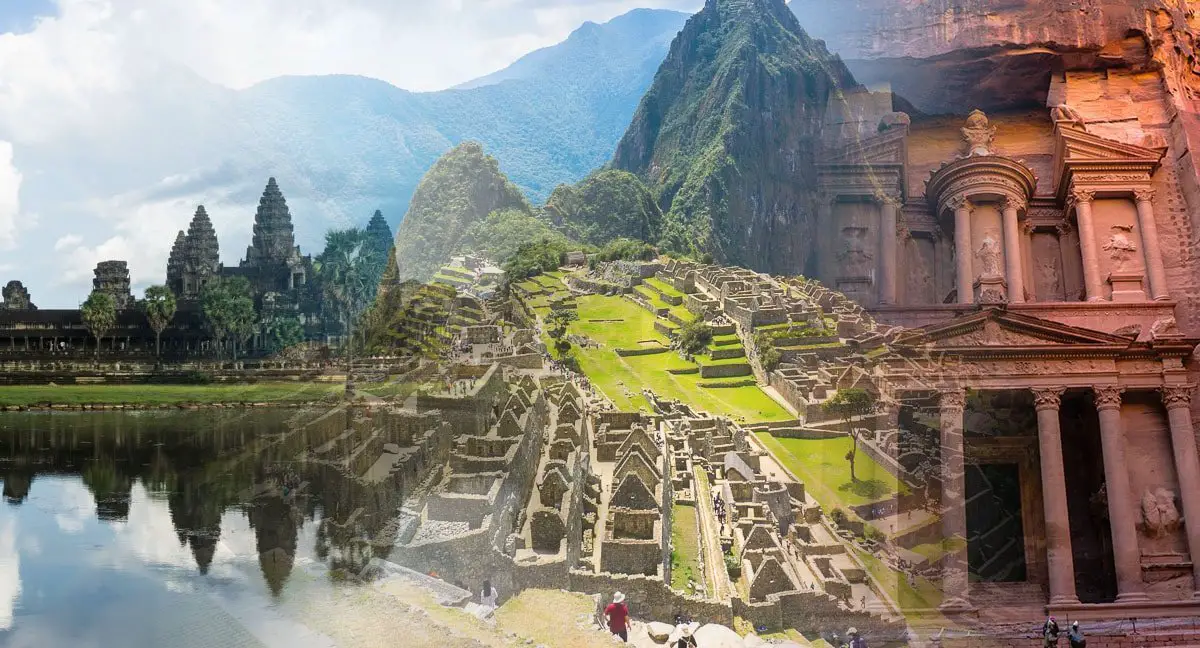

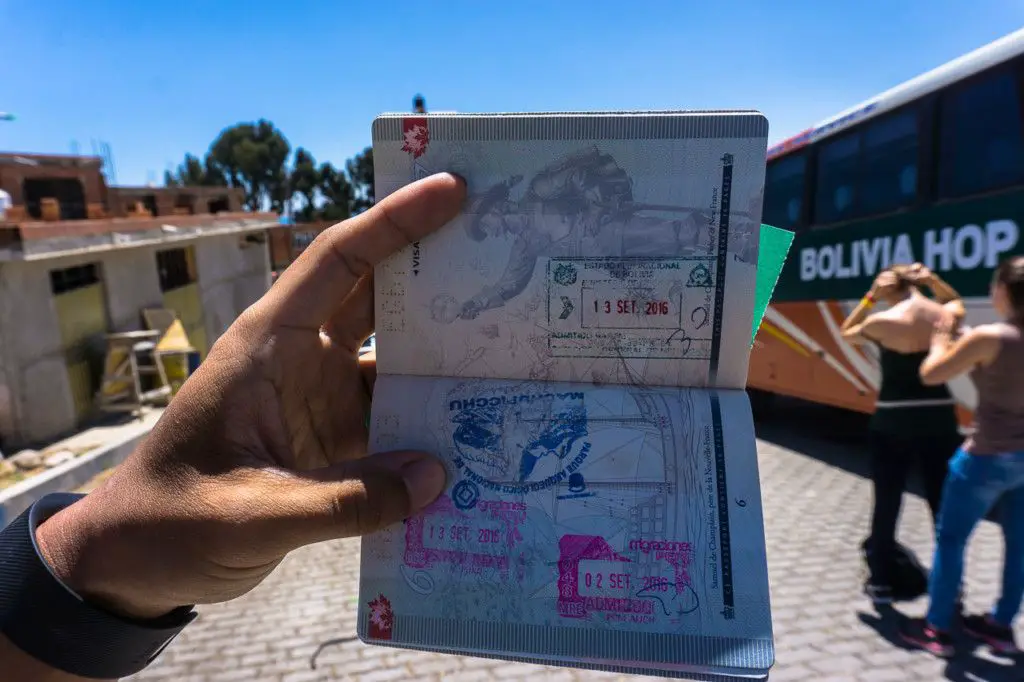

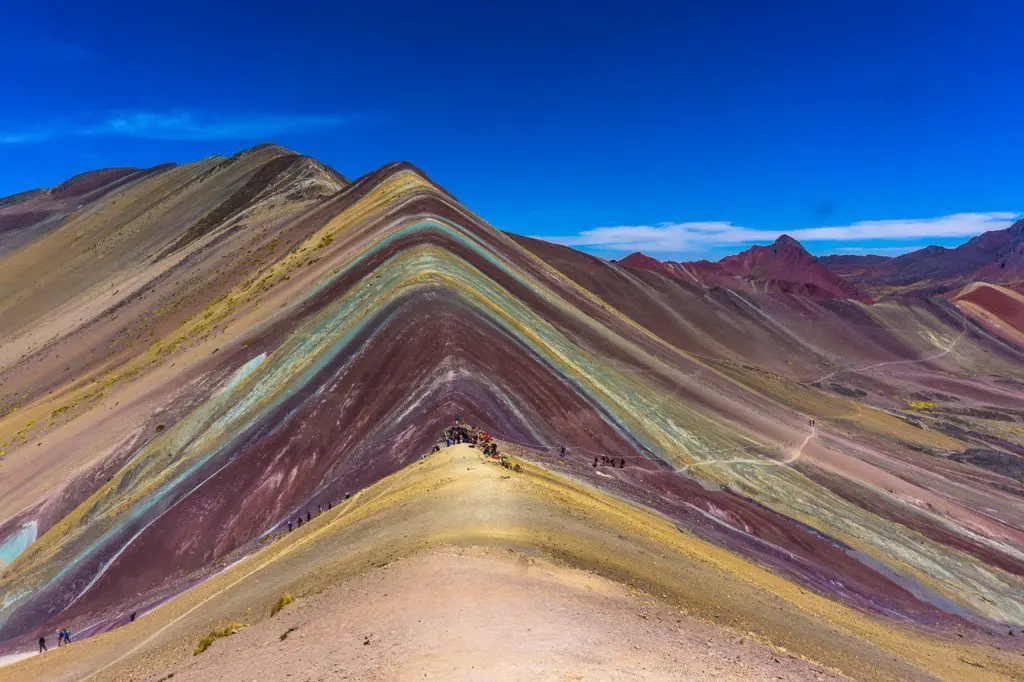
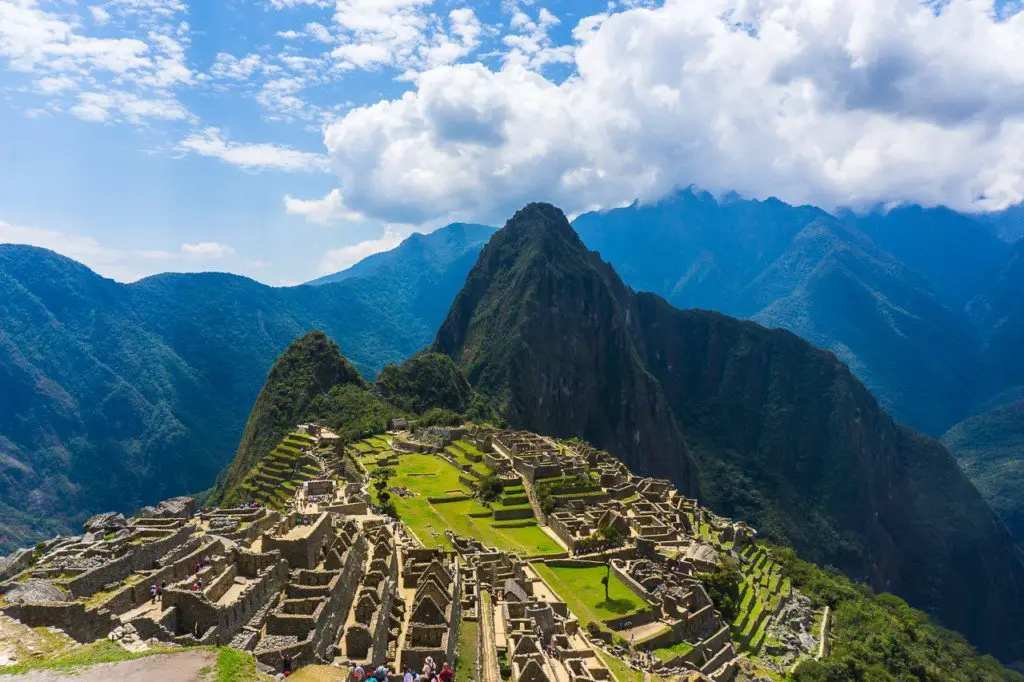

This is amazing. I love your 2 week itinerary for Peru and Bolivia! What month did you go for this trip?
Hey mate, glad you like the posts! I went in September for both countries. Hope you like it!
We are visiting the Salt Flats this summer. Which tour company did you use?
Hi Joanna, I went with Andes Salt Expeditions for my tour. But then again, all the tours are pretty much the same so just shop around for the best price!